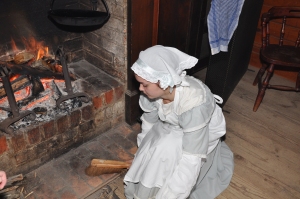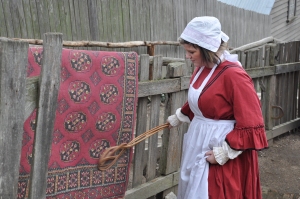The Household Arts: Sweeping, Beating and Scrubbing
Keeping the floors clean in the 1850s was a never-ending challenge! On the golfields, the early arrivals had to contend with the most basic of dwellings: tents and timbers huts, most of which had dirt floors. Some enterprising families and businesses would use crushed quartz for flooring as it was found to be a good way to avoid flea infestations. Even in the later years of the gold rush, many diggers would still live in huts and tents, allowing them to save their money and move on quickly as new leads were discovered.
For the wealthier arrivals (businessmen, bankers, government officials and the like) and those well-established mining families, a simple timber house with timber floors would have been the norm. Only the extremely wealthy families could have afforded stone houses and marble or slate floors. Most households would cover their cold and hard floors with as many rugs as they could afford.
Cleaning Dirt Floors
Needless to say, cleaning dirt floors was no easy task. Of course water could not easily be used without turning the floor to mud. Instead a basic broom would have been used to sweep the floor each day. The daily sweeping, combine with frequent foot traffic would turn the floor hard and solid. A well made dirt floor that had hardened could actually be mopped, although this would have be rare on the diggings.
Cleaning timber or stone floors
Timber and stone floors would also have been swept. There were many different brooms and brushes used, to ensure all areas were appropriately cleaned. There were special brushes designed for skirting boards, hearths and the like. There were also brushes with stiff bristles that could be used for scrubbing floors. Abrasive cleaners, like sand or salt, would often be used to scrub floors, along with soap as necessary.
Another cleaning trick from the time was to save up used tea leaves and then sprinkle them on the floor. They would gather the dust and then could be easily swept up, avoiding brushing dust back into the air.
Cleaning rugs or carpets
Before the invention of the vacuum cleaner in the 20th century, carpets and rugs could be very hard to clean. In the 1850s they would not be attached to the floor so they could be easily lifted up and carried out side to be given a good beating. Rug beaters were a very effective way of removing the dust and dirt. There were also carpet brooms that helped clean the carpets without the need to take them outside.
Regular chores that kept the house clean were a time-consuming affair in the 19th century. A lady that managed a house without the help of servants would need to be fit and energetic, and she would often expect a lot of assistance from her children. How do you think you would manage keeping your house clean without the aid of electricity?











Pingback: Eliza Perrin: An “Ordinary” Woman of the Goldfields « Gold Museum, Ballarat
Pingback: Eliza Perrin: An “Ordinary” Woman of the Goldfields – Gold Museum, Ballarat
never thought of fleas being a problem – what other pests needed stopping and what did they do about flies??
Fly swats and sticky fly-strip traps were used, but you can imagine the dirty conditions made it a challenge to keep the flies off your food.
I remember as a child my mother sprinkling coffee grounds on our carpet this was in the late fifties and maybe even into the sixties needless to say we were poor could not afford a vacuum cleaner it’s a good thing the carpet was a dark Color. This was 65 or 70 years ago as I am now almost 75.